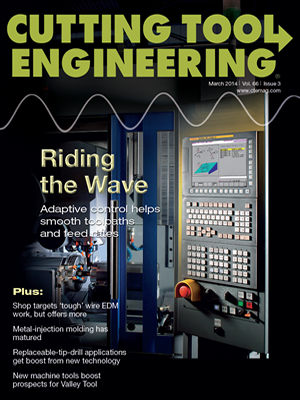From alpha to omega, Omega Manufacturing provides the complete “alphabet” of parts manufacturing services, including CNC and manual machining, grinding, honing, sawing, wire and sinker EDMing, prototyping, part design and assembly. Nonetheless, wire EDMing remains the heart of the business that President Ron Hunte established 17 years ago.
“I’ve always enjoyed wire EDMing,” he said. “I call them ‘miracle machines,’ because when you’re trying to do the difficult parts that a lot of guys are looking at machining conventionally, they just can’t do what a wire EDM does.” According to Hunte, that includes efficiently cutting hardened components, producing tight corners and creating “crazy shapes” as long as the workpiece material is electrically conductive.
Straight Out of Upstate
Hunte started his career as an automotive engineer for General Motors after graduating in 1985 from General Motors Institute. “GMI was a very rigorous engineering school that stressed ‘hands-on’ engineering,” he said. Hunte added that the institute produced Mary T. Barra, GM’s current and first female CEO, who also graduated in 1985 and was a sister of Beta Theta Pi, the same fraternity that Hunte belonged to. “I knew her very well, but I’ve lost touch,” he said. “It’s nice to have an engineer in charge of GM again instead of all the financial people.”
With machining in his blood, Hunte worked from 1989 to 1996 with his three brothers at their machine shop, Omega Consolidated Corp., Hilton, N.Y., which is near Rochester and the town of Greece. One of the shop’s customers was EDM builder Agie/Elox, so Hunte became more familiar with the technology by making major components for the machines. While visiting the builder’s facility near Charlotte, N.C., in 1996, Hunte became impressed with the area’s manufacturing vibrancy and growth, especially in contrast to the downsizing occurring at some of the large companies in and around Rochester.
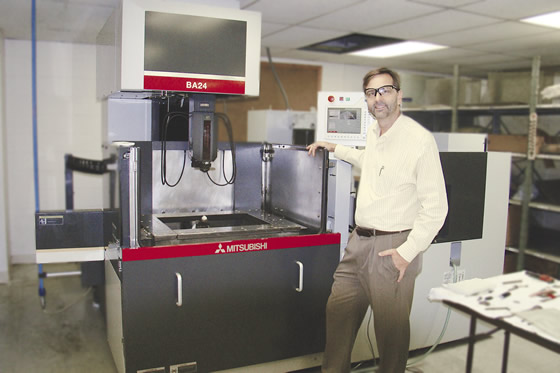
Courtesy of All images: A. Richter
Ron Hunte, president of Omega Manufacturing, with the company’s newest wire EDM, a Mitsubishi BA24.
Hunte failed to convince his brothers to pull up their roots and relocate, but he wasn’t so firmly planted.
“I was kind of down for a while, and then I decided to leave,” he recalled. “So I parted with my brothers and started in Charlotte.”
Although the new shop has no official ties with Omega Consolidated, Hunte felt the indirect association would help launch his new operation. “I like the name,” he said. “Like the last word in the Greek alphabet—it’s the last word in machining.”
Targeting the Terible
To help get the word out about his company, Hunte sought challenging applications that would showcase the unique capabilities of wire EDMing. “When I first started, I prided myself on being able to do the difficult jobs, the jobs nobody else wanted.”
That approach generated business, but there were not enough “terrible” jobs to keep his employees continually busy, so the shop also sought out less-demanding parts. “Then it went much better,” Hunte said. “If I just go for the challenging stuff, I’m going to go out of business, so I have to get the other stuff to keep right on rolling.”
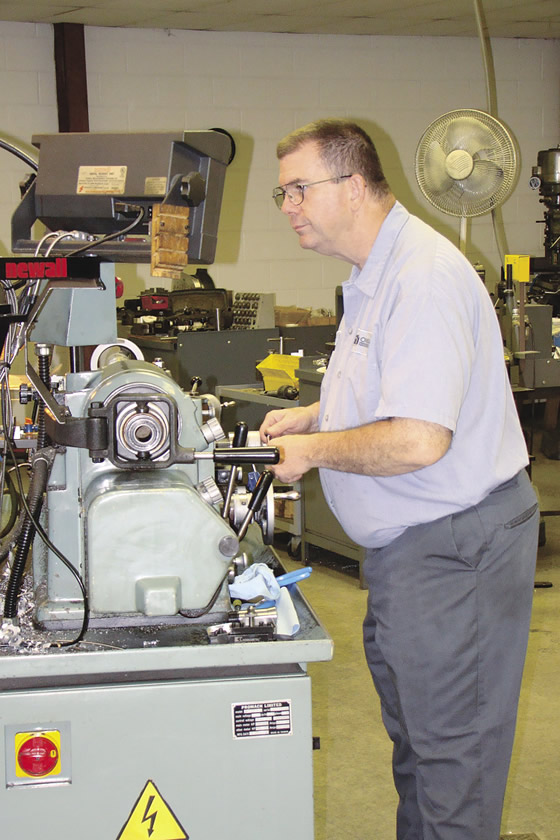
Dave Tenhengel, a journeyman machinist at Omega, turns a one-of-a-kind part on a manual toolmaker’s lathe.
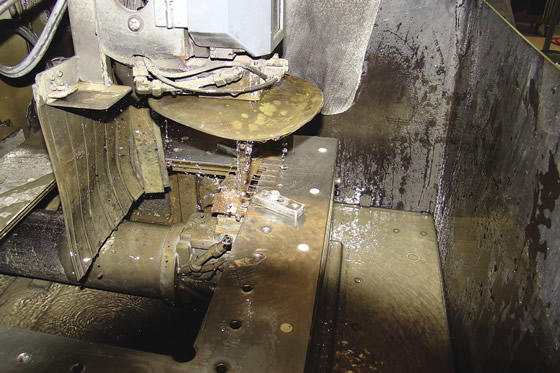
Omega started as a wire EDM shop and continues to specialize in that EDM technology.
After Omega established itself as a high-quality wire EDM shop, people started requesting that it perform sinker EDM work, not understanding that all EDMing isn’t the same, Hunte noted. While he prefers wire EDMing to the oil-centric and “stinky sinker stuff,” Hunte nonetheless purchased a couple of sinker EDMs, as well as other types of manual and CNC machine tools, to meet demand.
Hunte said one of the shop’s bread-and-butter jobs for the sinker EDMs is purposefully creating simulated weld flaws on components for ultrasonic testing equipment. “You can’t really high-speed mill a tiny 0.020 "-wide, 0.200 "-deep flaw, simulating cracks in welded piping, for example, for nuclear power plants.”
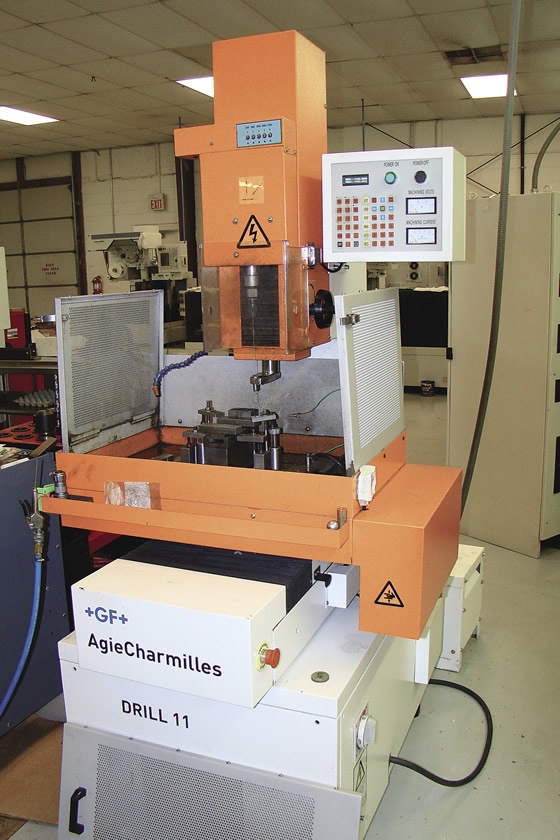
Omega uses its AgieCharmilles Drill 11 hole popper, with its optional power supply attachment, for high-precision small-hole EDMing.
On the wire side, in addition to making parts for customers, Omega makes special form tools for application in-house on its turning centers. For example, a special is needed to produce a V groove in a tube welding application. The company’s four wire EDMs are all Mitsubishis, with the newest being a Model BA24. Hunte explained that he selected Mitsubishi wire EDMs to handle production work because they are known for their ability to cut quickly and produce accurate parts. Part tolerances are as tight as ±0.0001 ", which require skim cutting, and part runs range from one-of-a-kind items, such as fixtures, to 10,000-piece orders.
He added that the larger runs are “not automotive-type production,” but Omega does serve one automotive area: NASCAR. Specifically, the shop works with Stewart-Haas Racing and Hendrick Motorsports, primarily machining chassis components, housings and brake caliper components, as well as wire EDMing parts like splines. “NASCAR teams don’t throw money around and they’re definitely cost-conscious, but often the race is coming up and they’ve got to have it,” Hunte said, noting it’s some of the shop’s most enjoyable work. “We’ve turned on a dime for them on several occasions.”
A third type of EDMing Omega performs is small-hole drilling with an AgieCharmilles Drill 11 hole popper. That machine has an optional power supply attachment to precisely produce holes from 0.006 " to 0.015 " in diameter. He said the hole popper can achieve the smallest holes in conductive material up to 0.200 " thick, whereas the larger ones are up to nearly 2 " deep. “But if you don’t have the right power supply, you won’t have luck doing that.”
Most Important Asset
From the company’s humble start with “basically nothing,” Omega has grown to a 15,000-sq.-ft. shop employing 15 people. One recent hire is Account Manager MaryKatherine Lowry. “She’s trying to get more work in here,” Hunte said, adding that Omega previously relied on word of mouth to generate new business. “It’s a slow way to grow. I’m the son of German immigrants and we don’t like to spend money on wasteful things like advertising.”
Because Omega continues to attract difficult jobs, the company looks for workers who want to be challenged and work for a small company, Hunte pointed out. “That’s a huge challenge. We would be bigger if I could only find two things: more work and more people to do it.”
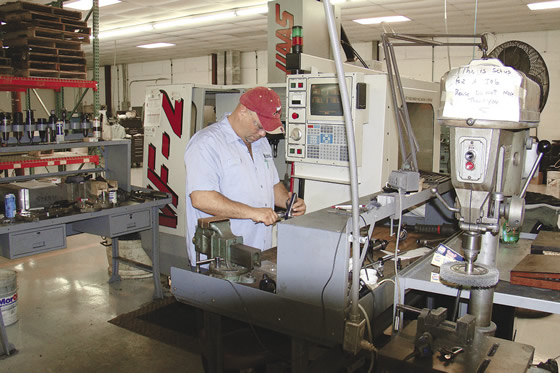
Alan Jackson, a CNC machinist at Omega, checks the ID of a machine component.
To assist with training, workers occasionally attend Central Piedmont Community College, which has a “strong manufacturing program,” Hunte said. He noted President Obama mentioned the school in his 2012 state-of-the-union address. In addition, an instructor from the college visited Omega during the evening hours to help Hunte and a programmer learn the latest Mastercam CAM software package.
“A hundred years ago when I first started getting into CAM programs, Mastercam was the one I picked and I just stuck with it. It is all-encompassing,” Hunte said, noting the software is suitable for turning, milling and EDMing. He added that Omega also uses ProCAM for simpler parts.
Because of his manufacturing engineering background, Hunte said he frequently assists customers with part design for manufacturability—regardless of whether they ask or not. “Customers know when they come to me that I’m going to give them some feedback if I can. I might ask, ‘Why are you making this out of two pieces when I can wire EDM it and it can be all one?’ Sometimes it’s not wanted and they say, ‘We know what we’re doing and this is what we want.’ I’m good with that and I understand my role, but I just can’t help myself when I see something glaring.”
Competitive Issues
Omega continues to add capabilities, such as laser engraving for serializing components and providing part traceability, and is eyeing 3D printing technology. He said: “3D printing is very neat. Some think it might make us all obsolete. That’s the fear my wife has, that we’re going to make everything on 3D printers. I say, ‘Not so fast.’ ”
When a job involves operations that Omega doesn’t perform, such as sheet-metal fabrication and welding, it will outsource, albeit reluctantly. “If I had my druthers, I would accept just the work we can do here,” Hunte said. The outsourcing includes a bit of machining, typically when the shop gets overloaded. “I always thought I don’t want to make my money on somebody else’s work—I want to make it on my own work.”
That work includes assisting “friendly competitors,” he said. “They compete head-to-head with us [on traditional machining jobs] but then come us for EDMing.” Examples include sinker EDMing a broken tap to remove it from a part and wire EDMing a hole a shop missed placing in a part before it was heat treated. The alternative involves annealing the part, drilling it, heat treating it again, regrinding it and otherwise finishing the part.
The vast majority of Omega Manufacturing’s customers are local or regional and Hunte is fine with that. “I believe in staying somewhat local,” he said. “If I could draw a circle of where we could get to in maybe 3 hours, that’s where I would like all of our customers to come from.” Nonetheless, out-of-state work is not unusual, sometimes as a result of a previously local contact moving and continuing to direct business to Omega.
The machine shop, however, plans to stay put in Charlotte as major energy-related companies, such as Siemens, AREVA and the Electric Power Research Institute, help to transform the Queen City while generating jobs.
“They always talk about banking in connection with Charlotte,” Hunte said, “but the number two employer in Charlotte is manufacturing.”
For more information about Omega Manufacturing, call (704) 597-0418 or visit www.omega-mfg.com. CTE
Related Glossary Terms
- annealing
annealing
Softening a metal by heating it to and holding it at a controlled temperature, then cooling it at a controlled rate. Also performed to produce simultaneously desired changes in other properties or in the microstructure. The purposes of such changes include improvement of machinability, facilitation of cold work, improvement of mechanical or electrical properties and increase in stability of dimensions. Types of annealing include blue, black, box, bright, full, intermediate, isothermal, quench and recrystallization.
- centers
centers
Cone-shaped pins that support a workpiece by one or two ends during machining. The centers fit into holes drilled in the workpiece ends. Centers that turn with the workpiece are called “live” centers; those that do not are called “dead” centers.
- computer numerical control ( CNC)
computer numerical control ( CNC)
Microprocessor-based controller dedicated to a machine tool that permits the creation or modification of parts. Programmed numerical control activates the machine’s servos and spindle drives and controls the various machining operations. See DNC, direct numerical control; NC, numerical control.
- computer-aided manufacturing ( CAM)
computer-aided manufacturing ( CAM)
Use of computers to control machining and manufacturing processes.
- electrical-discharge machining ( EDM)
electrical-discharge machining ( EDM)
Process that vaporizes conductive materials by controlled application of pulsed electrical current that flows between a workpiece and electrode (tool) in a dielectric fluid. Permits machining shapes to tight accuracies without the internal stresses conventional machining often generates. Useful in diemaking.
- gang cutting ( milling)
gang cutting ( milling)
Machining with several cutters mounted on a single arbor, generally for simultaneous cutting.
- grinding
grinding
Machining operation in which material is removed from the workpiece by a powered abrasive wheel, stone, belt, paste, sheet, compound, slurry, etc. Takes various forms: surface grinding (creates flat and/or squared surfaces); cylindrical grinding (for external cylindrical and tapered shapes, fillets, undercuts, etc.); centerless grinding; chamfering; thread and form grinding; tool and cutter grinding; offhand grinding; lapping and polishing (grinding with extremely fine grits to create ultrasmooth surfaces); honing; and disc grinding.
- inner diameter ( ID)
inner diameter ( ID)
Dimension that defines the inside diameter of a cavity or hole. See OD, outer diameter.
- lathe
lathe
Turning machine capable of sawing, milling, grinding, gear-cutting, drilling, reaming, boring, threading, facing, chamfering, grooving, knurling, spinning, parting, necking, taper-cutting, and cam- and eccentric-cutting, as well as step- and straight-turning. Comes in a variety of forms, ranging from manual to semiautomatic to fully automatic, with major types being engine lathes, turning and contouring lathes, turret lathes and numerical-control lathes. The engine lathe consists of a headstock and spindle, tailstock, bed, carriage (complete with apron) and cross slides. Features include gear- (speed) and feed-selector levers, toolpost, compound rest, lead screw and reversing lead screw, threading dial and rapid-traverse lever. Special lathe types include through-the-spindle, camshaft and crankshaft, brake drum and rotor, spinning and gun-barrel machines. Toolroom and bench lathes are used for precision work; the former for tool-and-die work and similar tasks, the latter for small workpieces (instruments, watches), normally without a power feed. Models are typically designated according to their “swing,” or the largest-diameter workpiece that can be rotated; bed length, or the distance between centers; and horsepower generated. See turning machine.
- milling
milling
Machining operation in which metal or other material is removed by applying power to a rotating cutter. In vertical milling, the cutting tool is mounted vertically on the spindle. In horizontal milling, the cutting tool is mounted horizontally, either directly on the spindle or on an arbor. Horizontal milling is further broken down into conventional milling, where the cutter rotates opposite the direction of feed, or “up” into the workpiece; and climb milling, where the cutter rotates in the direction of feed, or “down” into the workpiece. Milling operations include plane or surface milling, endmilling, facemilling, angle milling, form milling and profiling.
- milling machine ( mill)
milling machine ( mill)
Runs endmills and arbor-mounted milling cutters. Features include a head with a spindle that drives the cutters; a column, knee and table that provide motion in the three Cartesian axes; and a base that supports the components and houses the cutting-fluid pump and reservoir. The work is mounted on the table and fed into the rotating cutter or endmill to accomplish the milling steps; vertical milling machines also feed endmills into the work by means of a spindle-mounted quill. Models range from small manual machines to big bed-type and duplex mills. All take one of three basic forms: vertical, horizontal or convertible horizontal/vertical. Vertical machines may be knee-type (the table is mounted on a knee that can be elevated) or bed-type (the table is securely supported and only moves horizontally). In general, horizontal machines are bigger and more powerful, while vertical machines are lighter but more versatile and easier to set up and operate.
- sawing
sawing
Machining operation in which a powered machine, usually equipped with a blade having milled or ground teeth, is used to part material (cutoff) or give it a new shape (contour bandsawing, band machining). Four basic types of sawing operations are: hacksawing (power or manual operation in which the blade moves back and forth through the work, cutting on one of the strokes); cold or circular sawing (a rotating, circular, toothed blade parts the material much as a workshop table saw or radial-arm saw cuts wood); bandsawing (a flexible, toothed blade rides on wheels under tension and is guided through the work); and abrasive sawing (abrasive points attached to a fiber or metal backing part stock, could be considered a grinding operation).
- tap
tap
Cylindrical tool that cuts internal threads and has flutes to remove chips and carry tapping fluid to the point of cut. Normally used on a drill press or tapping machine but also may be operated manually. See tapping.
- turning
turning
Workpiece is held in a chuck, mounted on a face plate or secured between centers and rotated while a cutting tool, normally a single-point tool, is fed into it along its periphery or across its end or face. Takes the form of straight turning (cutting along the periphery of the workpiece); taper turning (creating a taper); step turning (turning different-size diameters on the same work); chamfering (beveling an edge or shoulder); facing (cutting on an end); turning threads (usually external but can be internal); roughing (high-volume metal removal); and finishing (final light cuts). Performed on lathes, turning centers, chucking machines, automatic screw machines and similar machines.
- ultrasonic testing
ultrasonic testing
Nonconductive test applied to sound-conductive materials having elastic properties for the purpose of locating inhomogeneities or structural discontinuities within a material by means of an ultrasonic beam.
- wire EDM
wire EDM
Process similar to ram electrical-discharge machining except a small-diameter copper or brass wire is used as a traveling electrode. Usually used in conjunction with a CNC and only works when a part is to be cut completely through. A common analogy is wire electrical-discharge machining is like an ultraprecise, electrical, contour-sawing operation.


